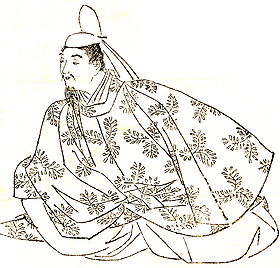
Fujiwara no Yoshifusa (藤原 良房, 804 – October 7, 872), also known as Somedono no Daijin or Shirakawa-dono, was a Japanese statesman, courtier and politician during the Heian period.
When Yoshifusa's grandson was enthroned as Emperor Seiwa, Yoshifusa assumed the role of regent (sesshō) for the young monarch. He was the first sesshō in Japanese history who was not himself of imperial rank; and he was the first of a series of regents from the Fujiwara clan.
Career
He was a minister during the reigns of Emperor Ninmyō, Emperor Montoku and Emperor Seiwa.
- 834 (Jōwa 1, 9th day of the 7th month): Sangi
- 835 (Jōwa 2): Gon-no-Chūnagon
- 840 (Jōwa 7): Chūnagon
- 842 (Jōwa 9): Dainagon
- 848 (Saikō 1, 1st month): Udaijin
- 857 (Saikō 4, 19th day of the 2nd month): Daijō Daijin
- 858 (Ten'an 2, 7th day of the 11th month): Sesshō for Emperor Seiwa.
- October 7, 872 (Jōgan 14, 2nd day of the 9th month): Yoshifusa died at the age of 69.
Yoshifusa conceived the programme of boy-sovereigns with Fujiwara regents; and his adopted son, Mototsune, carried out the plans.
Genealogy
This member of the Fujiwara clan was the son of Fujiwara no Fuyutsugu. Yoshifusa's brothers were Fujiwara no Nagayoshi, Fujiwara no Yoshisuke and Fujiwara no Yoshikado.
Marriages and children
He was married to Minamoto no Kiyohime (源 潔姫), daughter of Emperor Saga.
They had only one daughter.
- Akirakeiko/Meishi (明子) (829–899), consort of Emperor Montoku
He adopted his brother Nagara's third son.
- Mototsune (基経) (836–891) – Daijō Daijin and Kampaku
Yoshifusa is referred to as Chūjin Kō (忠仁公) (posthumous title was Daijō Daijin).
See also
- Fujiwara Regents
- Shoku Nihon Kōki, one of the Six National Histories of Japan; edited by Fujiwara no Yoshifusa.
Notes
- ^ Nussbaum, Louis-Frédéric. (2005). "Fujiwara no Nakahira" in Japan Encyclopedia, p. 212, p. 212, at Google Books; Brinkley, Frank et al. (1915). A History of the Japanese People from the Earliest Times to the End of the Meiji Era, p. 203., p. 203, at Google Books
- Titsingh, Isaac. (1834). Annales des empereurs du japon, p. 135., p. 135, at Google Books; see "Fousiwara-no Yosi fousa", pre-Hepburn romanization
- Titsingh, p. 114., p. 114, at Google Books; Brown, Delmer et al. (1979). The Future and the Past, p. 285; n.b., Yoshifusa was the first minister to be promoted to Daijō-daijin. That high office was previously filled by Imperial Princes only.
- Brown, p. 286.
- Titsingh, p. 120., p. 120, at Google Books.
- Brinkley, p. 237., p. 237, at Google Books
- Brinkley, p. 203., p. 203, at Google Books
- Titsingh, p. 114., p. 114, at Google Books
- Florenz, Karl. (1906) Geschichte der japanischen Litteratur, Vols. 1-2, p. 208., p. 208, at Google Books
References
- Brinkley, Frank and Dairoku Kikuchi. (1915). A History of the Japanese People from the Earliest Times to the End of the Meiji Era. New York: Encyclopædia Britannica. OCLC 413099
- Brown, Delmer M. and Ichirō Ishida, eds. (1979). Gukanshō: The Future and the Past. Berkeley: University of California Press. ISBN 978-0-520-03460-0; OCLC 251325323
- (in Japanese) Hioki, S. (1990). Nihon Keifu Sōran. Tokyo: Kōdansya.
- (in Japanese) Kasai, M. (1991). Kugyō Bunin Nenpyō. Tokyo: Yamakawa Shuppan-sha
- (in Japanese) Kodama, K. (1978). Nihon-shi Shō-jiten, Tennō. Tokyo: Kondō Shuppan-sha.
- Nussbaum, Louis-Frédéric and Käthe Roth. (2005). Japan encyclopedia. Cambridge: Harvard University Press. ISBN 978-0-674-01753-5; OCLC 58053128
- (in Japanese) Owada, T. et al. (2003). Nihonshi Shoka Keizu Jimmei Jiten. Tokyo: Kōdansya.
- Titsingh, Isaac. (1834). Nihon Odai Ichiran; ou, Annales des empereurs du Japon. Paris: Royal Asiatic Society, Oriental Translation Fund of Great Britain and Ireland. OCLC 5850691
| Fujiwara family tree | |
|---|---|
Notes
|